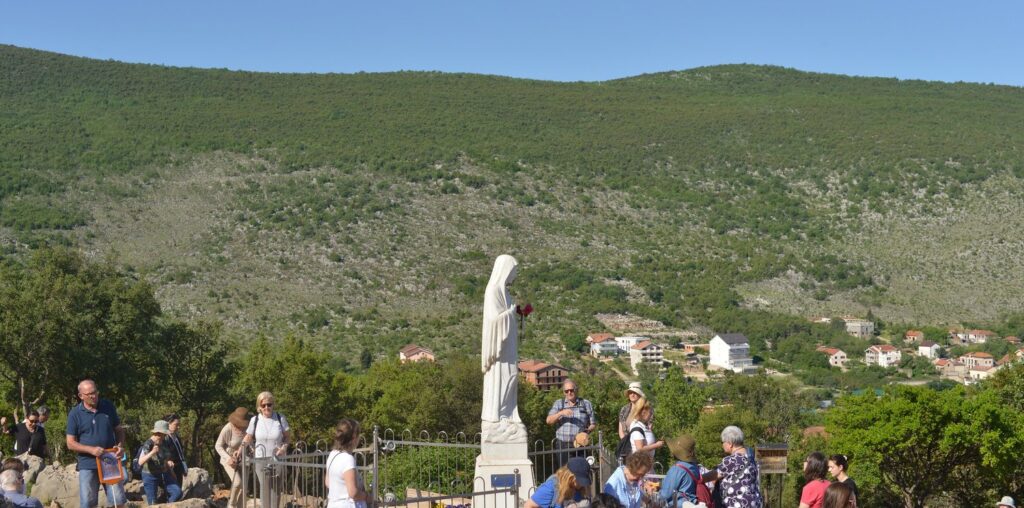
Church guidelines for discernment
The church has always set guidelines for discerning the truth of visions. A seer must be healthy and their visions must not contradict Catholic doctrine.
Additionally, the seer must not seek profit or fame from their experiences or use visionary claims as a pretext for exploitation. They must not spread “a sectarian mentality” that would subvert church authority.
Until now, local bishops investigated reports of supernatural phenomena in their dioceses, then either declared them safe for Catholics or shut them down. Sometimes a complex case led bishops to seek private help from the dicastery.
The process varied across dioceses and could take years to complete — 43 in the case of Medjugorje. If the church finds nothing troubling about the proclaimed visionary, Catholics are allowed but not required to believe in the vision.
New norms
The dicastery’s revised norms of discernment may be a response to increasing Catholic claims to supernatural experience. Global media not only spread but encourages reports of visions and apparitions.
The newly revised norms make three important changes to the process.
First, the new norms put the decision about supernatural phenomena in the hands of the dicastery. It streamlines the process and prevents local politics or any single bishop’s opinions from clouding final assessment of the declared apparition.
Second, the dicastery has reduced assessment of visions to one of six outcomes. The least positive decision is that there’s nothing supernatural going on.
The most positive ruling — short of the pope’s official declaration that the phenomenon is unarguably supernatural — is “Nihil obstat,” meaning “nothing hinders.”
This means the event presents “many signs of the action of the Holy Spirit,” and that the visionary shows no serious flaws that would prevent Catholics from supporting the phenomenon.
The third is that the apparition can be genuine even if the alleged seers have made minor errors of interpretation or behavior. It recognizes that visionaries sometimes cannot properly articulate what they see, or they may misinterpret the virgin — for instance, suggesting Mary is angry with those who ignore her warnings. Seers need not be perfect Catholics, either.
Belief in the Virgin of Medjugorje
Despite personal criticisms of the seers, such as accusations that they have profited from their fame, the dicastery found that apparitions at Medjugorje have led to profound “positive fruits” for thousands of people.
One survey at the vision site found that 48.8% of visitors to Medjugorje said their lives were changed by the experience; 30.4% believed their lives were “very much” changed; and 14.5% said they were “radically” changed.
Granted, pilgrims are often predisposed to spiritual growth, yet the majority of visitors to Medjugorje claimed deepened faith. Some were moved to seek ordination or able to conquer what they considered sinful habits; some others reconciled with family members, were healed of illness or disability, or witnessed small miracles.
Still, the dicastery suggests that pilgrims should visit and pray at places associated with the “original events” at Medjugorje, such as the hill of Podbrdo, rather than watching the seers in trance.
A Vatican commission in 2010 had decided that the first seven apparitions and related messages were supernatural, but the commission was not convinced about the rest.
Why now?
Changes in the norms for discernment have come at a moment when church leaders claim to be listening to ordinary believers. Pope Francis recently concluded a three-year Synod on Synodality that brought parish priests, lay people and even dissenting theologians together with church leaders in Rome to ponder solutions.
Long-term issues important to the laity, such as inclusion of LGBTQ+ Catholics and women’s ordination, were discussed but left unresolved. Yet the synod achieved some structural reforms aimed at including the ideas and opinions of regular Catholics. Early in the deliberations, the synod itself warned against the “sin … of lack of listening, communion, and participation of all.”
Perhaps the dicastery is paying attention to the experience of pilgrims.
No matter what the supposed visionaries do or say or whether the virgin appears there or not, many visitors say going to Medjugorje makes them better Catholics. Over 43 years, millions of pilgrims have believed in the apparitions at Medjugorje.
It appears that, given the dicastery’s recent ruling of “Nihil obstat,” nothing prevents Catholics from devotion to Our Lady of Medjugorje, the Queen of Peace.
This piece is republished from The Conversation.

